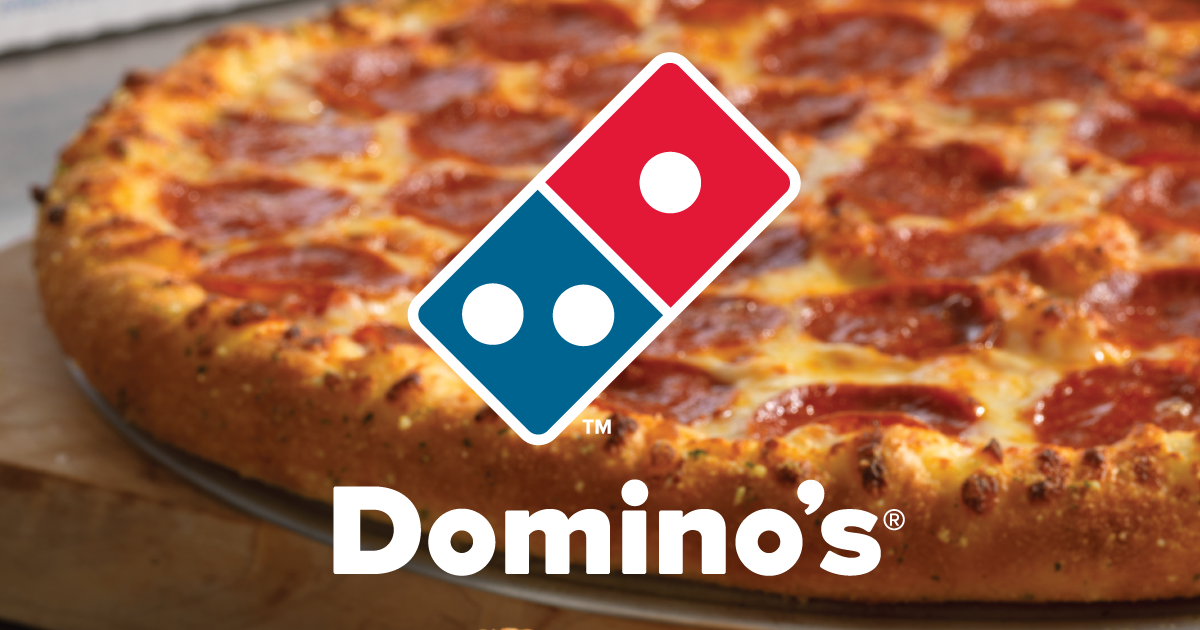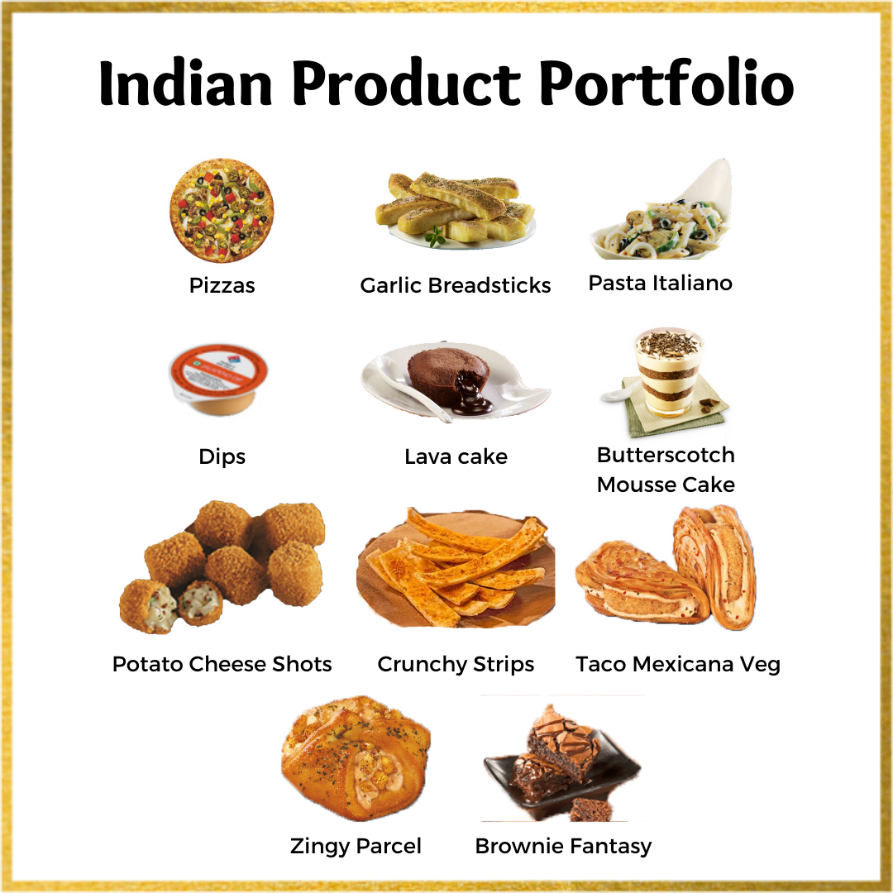Today, Domino’s Pizza is among the top five world’s leading quick-service restaurants in terms of brand value and has a brand valuation of over eight billion US dollars. They were the first to introduce the concept of “thirty minutes or less” delivery time. Globally, they’ve retail stores in more than 5500 cities, and almost half of them are in the US. But the height that they’ve reached today has not been possible without its fair share of struggles.
History
Domino’s started with a different name, “Dominick’s,” a small Michigan Pizzeria bought by Tom and James Monaghan in 1961. While both had planned to be equally committed to the new business, James found it difficult to handle both his full-time job as a postman and the pizza business. Within eight months, he sold his shares of the company for the second-hand car they used for the deliveries. This did not deter Tom, who purchased two more pizzerias, wishing them to have the same brand name. When the original owner forbade him from doing so, he revitalized the brand by changing the name to “Domino’s” in 1965.
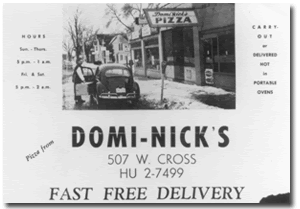
The original logo of Domino’s had the three dots signifying the three stores, about which Tom had the idea to increase the dots in accordance with the stores. However, this idea quickly faded, as Domino’s had rapid growth from thereon. Their first franchise location was opened in 1967 and then got expanded to 200 franchise branches by 1978.
Taking confidence from the rapid growth, Domino’s opened its first international store in Winnipeg, Canada, in 1983, and by 1995, they had expanded to 1000 international stores. There was no stopping Domino’s now, and it quickly climbed up the ladder to be at the height it is now.
Domino’s logo over the years
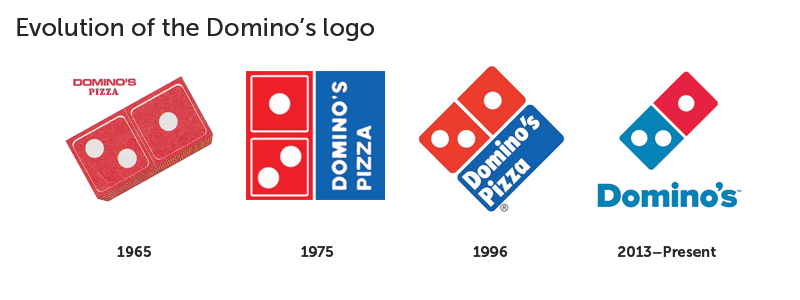
Marketing Mix
Product – Pizza is one of the leading products of Domino’s. It is a sign of their success that nowadays when people think of pizza, the name of Domino’s automatically comes to their mind. They offer pizzas in various tiers, and each tier has numerous varieties of pizza. In several stores, there is an option of even making your own pizza. Other than a vast collection of pizzas, Domino’s menu includes pasta, breadsticks, garlic bread, chicken wings, sandwiches among numerous items.
Price – Domino’s captures a vast audience because of its pricing range. They’ve lower as well as higher ranged, differentiated in their menu according to the tiers. In the event of making your own pizza, the pricing is dependent upon the crust you select, or the topping(s) you choose. The beverages sold are relatively higher priced than those at general stores.
Place – Domino’s operates on a franchise model; almost 97% of its business is franchise owned. They’ve more than 15,000 franchises in over 80 countries worldwide. They have a very successful delivery system, i.e., “thirty minutes or less,” in which they promise to give the delivery for free if they cross the thirty minutes limit.
Promotion – As the primary consumer base for Domino’s is online-based, much of their promotion is done online too. They use Twitter, YouTube, and other social networking sites for their marketing. They’ve also collaborated with several celebrities and use television advertisements to showcase their “thirty minutes or less” guarantee.
SWOT Analysis
Strengths
- Brand Recall – Due to its creative taglines and aggressive marketing, they’ve created a dominating presence in the pizza market. Especially in India, it’s the brand everyone thinks of when thinking of pizza.
- Product Innovation – Over the course of 50 years or so, Domino’s focus has always remained on product innovation in order to attract new customers. They’ve innovated several products that have highly satisfied the consumer base, and are sure to do the same in the future.
- Efficient supply chain – The one thing that customers dislike more than anything is having to wait for their food. Domino’s has differentiated itself by its “thirty minutes or less” delivery strategy, and thus create its hype among the consumer base.
Weaknesses
- Low staff retention – High attrition rate is a significant fault in Domino’s. As much of the employee base is unskilled, or at least without proper training, these employees tend to quit whenever they start to find the work hectic.
- Operations – Due to a large number of stores, many times the quality of their food is gets affected. This in turn has a negative effect on their brand image.
- Decreasing market – Due to the increasing emphasis on eating healthy and diet-conscious food, the pizza market is declining in the older generation’s consumer base.
Threats
- Intense Competition – As Domino’s is at the 5th rank worldwide in the pizza market, it faces immense competition from its competitors like Pizza Hut, Papa John’s, etc. Apart from this direct competition, Domino’s also faces indirect competition from brands such as McDonald’s and KFC.
- Cost – With the increasing cost of vegetables and the other raw materials, the expense of managing the pizza franchises also rises up. This, along with maintaining a constant edge over the competitors creates a financial burden.
Opportunities
- Market Expansion – Domino’s can increase its presence in emerging markets like China or India.
- Restaurants or Eateries – By launching more dine-in facilities for the consumers, Domino’s can increase its consumer base by a wide margin.
- Health-conscious eatables – Domino’s can modify their menu by adding some food items for the diet-conscious consumer base, similar to what McDonald’s has done by incorporating whole wheat in their food products.
RoadMap
1961 – First restaurant under the name Dominick’s
1965 – Revitalised the brand name to Domino’s
1967 – First franchise store in Ypsilanti, Mich
1978 – Expansion to 200 stores
1983 – First international store, in Winnipeg, Canada
1985 – First store in Tokyo, Japan
1993 – Became the second American franchise to open in the Dominican Republic and the first one to open in Haiti
1995 – Expansion to 1,000 international stores
1996 – Opened their first outlet in India
1998 – Domino’s founder Tom Monaghan announced his retirement
1999 – Dave Brandon became the new CEO
2014 – Expansion to 6,000 international stores
2016 – Opened its 1,000th store in India
Marketing Strategies
- Acknowledging its critiques
After conducting focus group research in 2010, Domino’s received a lot of negative responses regarding their crust, sauces, and whatnot. Instead of trying to cover up or like, they accepted the criticisms and completely scrapped the older recipe. While launching the new and improved recipe, they also released an advertisement that featured the consumers bashing their old recipe. This brought many claps and respect to them, and ultimately everyone loved the new recipe.
- Social Media Strategy
In comparison with its competitors, Domino’s has a quite noticeable presence on social networking sites. They share relatable videos and advertisements that engage consumers on a personal level.
- Email and SMS Marketing
While not a significant form of marketing for Domino’s, they still use it quite frequently. Emails and SMSs are frequently sent regarding various offers and discounts.
- Campaigns
Over the years, Domino’s has launched several creative campaigns, which has been enthusiastically accepted by the consumer base. From wedding registries to automation, they’ve invested heavily in both product innovation and technological innovation.
Also Read: KFC – It’s Not Good, It’s Finger-Lickin’ Good
Strategy in India
Domino’s entered in India at a time when pizza was an alien concept here. They, along with “Pizza Hut,” had a challenging task ahead of them to build the pizza market in India. While they indeed could’ve followed the lead of Pizza hut, and made the experience of eating pizza equivalent to fine dining, they stuck to their original concept.
They represented themselves as a “delivery first” brand, where pizza is the hero, not the place. In India, where punctuality is more often than not just something you say, a clear penalty to the brand on delay was unheard of. People were intrigued by this, and thus started the wave of Domino’s in India.
Domino’s has also been very enthusiastic and proactive in marketing themselves. Keeping aside the social networking sites, they’ve established themselves as the go-to pizza place for everyone through their creative advertisements. They’ve given us some unforgettable taglines, such as “Yeh hai Rishton ka time” and “Khushiyon ki home delivery”. Through all these strategies, Domino’s has converted a purely western product into something with an Indian soul and immersed it into the local culture.
Along with marketing, Domino’s has made themselves famous by incorporating the local culture in their menu. Items like “Taco Indiana”, “Peppy Paneer Pizza” merges the local culture with western food, creating an irresistible temptation for the consumer base. While they have a relatively lean menu, they’ve smartly innovated and added several items like “Pizza mania”, a set of affordable pizzas, “Zingy parcel”, an affordable but delicious side to have with a pizza, “Garlic breadsticks”, again a side that goes perfectly with their pizzas and numerous others.
Another initiative taken by Domino’s was the Navratri Experiment. In the first year, they simply modified the menu according to the customer’s preferences which garnered an excellent response from the consumer base and it finally encouraged them to launch a complete Navratri menu next year itself.

After getting a very good response from the Navratri Experiment, Domino’s immersed itself entirely with the local Gujarat culture and made a move that left everyone stunned. They turned vegetarian permanently, and though this invited some negative reviews, the overall result was positive, as evident by their constant popularity even now. This was a highly risky move by Domino’s and had the potential to backfire drastically, but this did not deter Domino’s.
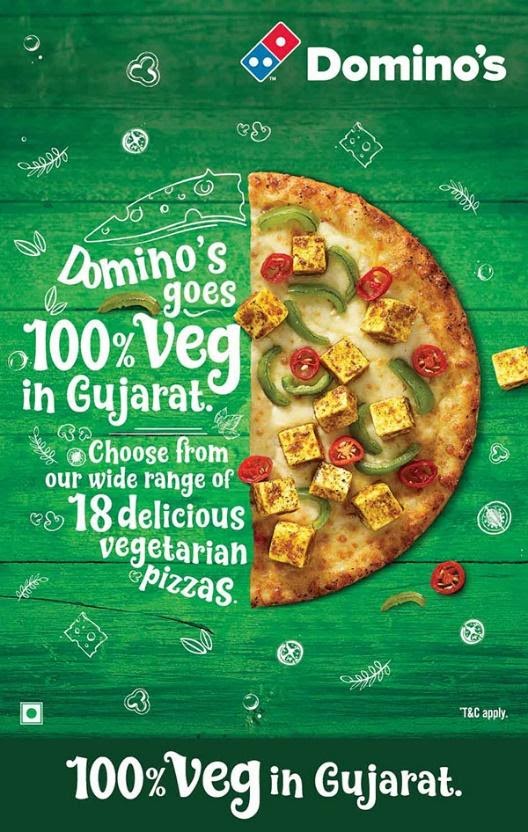
Popular campaigns
Over the years, Domino’s has launched more and more creative campaigns to market themselves. While not all of them have been successful, the successful ones proved to be very beneficial for the brand. Let’s have a look at some of the most famous campaigns from over the years.
- Domino’s Wedding Registry
In June 2017, Domino’s launched a rather creative campaign in which soon-to-be newlyweds could create their own pizza wedding registry. This increased its sales as well as online engagement, consequently benefitting the brand.
- Dom Juan on Tinder
While Domino’s sees a surge in its sales on Valentine’s day, Tinder is also highly popular on that day. In Feb 2018, Domino’s collaborated with Tinder and incorporated a “Dom Juan” tinder bot, which, on swiping right, gives the cheesiest pickup lines to use on your Tinder matches. While this doesn’t have any direct effect on sales, but Domino’s had always focused on connecting with the consumer base on a personal level. This blew up on Twitter and over other social networking sites, creating much hype over the brand.
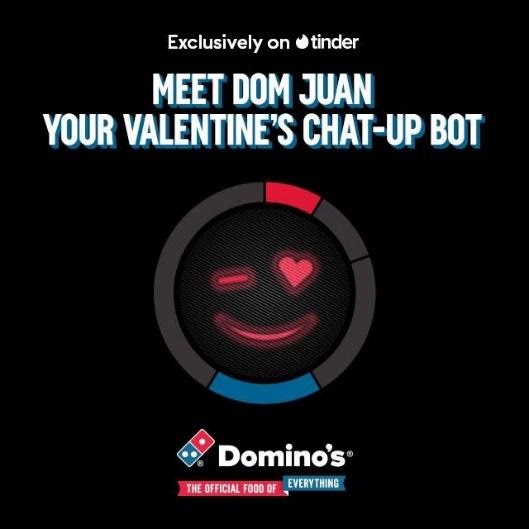
- The autonomous pizza robot
In another attempt to differentiate themselves and engage with the consumers personally, Domino’s collaborated with Starship technologies to launch a number of robots that could deliver pizzas within a radius of one mile. This initiative took place only in some German and Dutch cities. A similar strategy was applied in Austria, but no further expansion of this initiative can be seen on the horizon.
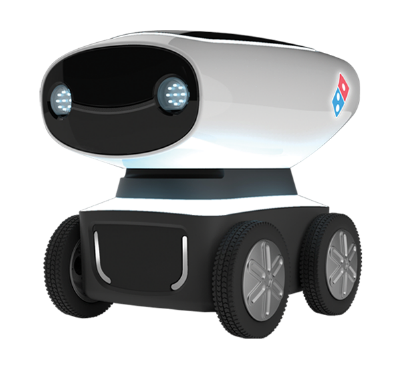
- Paving for Pizza
Throughout 2018, Domino’s gave grants of $5000 in 50 cities across the US to help fill potholes and repair damaged roads. They claimed that they’re only protecting their pizzas, and customers can vote online for their city to be paved. This blew up on Twitter and everywhere, and their brand recognition certainly got a boost. It also came to light that these grants had numerous stipulations, such as a time limit for the work completion, before and after photographs to be taken and given to the company, and a promise from Domino’s that any part of this campaign should not portray the construction workers in any negative light. While some saw this as a dangerous publicity stunt, there were also many claps for this initiative. As a marketing strategy for this initiative, they showed a video on their website about what happens to the pizza in the box on different road conditions.
